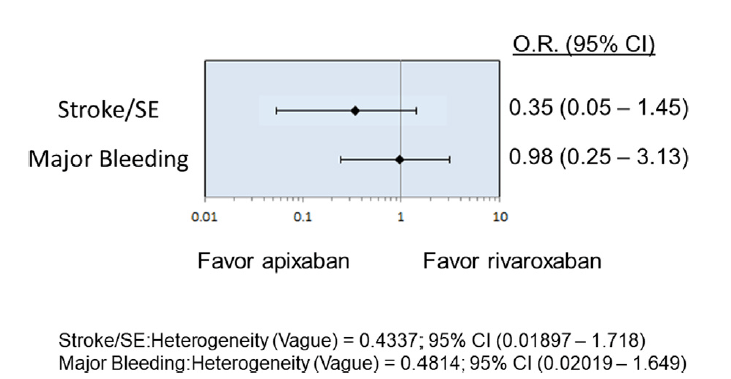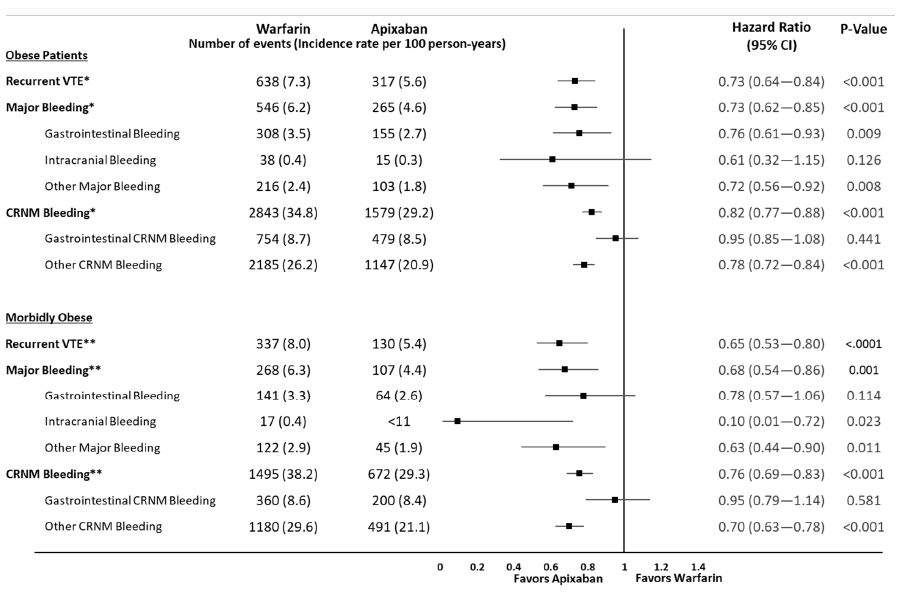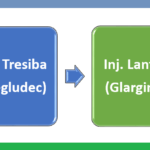Do you prefer using Xarelto or Eliquis for treating VTE (venous thromboembolism) in Obesity and overweight?
Obesity is a risk factor for thrombosis. The efficacy of the two commonly used DOACs (direct-acting oral anticoagulant), Apixaban and Rivaroxaban, has been questioned in obese and overweight individuals.
The International Society on Thrombosis and Hemostasis (ISTH) recommends against the use of Direct-acting oral anticoagulants (DOACs) in patients for the treatment or prevention of venous thromboembolism who are obese with a body weight of 120 kgs and a BMI of 120 kg/m² or more.
So, which is the best anticoagulant for obese patients? Apixaban or Rivaroxaban?
Before identifying the best anticoagulant for obese patients, it is important to know the major differences between the two anticoagulants:
What are Eliquis and Xarelto Used for?
Eliquis is the brand name of Apixaban, marketed by Pfizer. Xarelto is the brand name of Rivaroxaban, marketed by Bayer Healthcare.
These are directly-acting oral anticoagulants which have recently been approved by the FDA for the treatment of the following conditions:
Deep Vein Thrombosis:
It is a condition in which blood clots are formed in the venous system, predominantly in the legs and pelvic vessels. Blood clots form as a result of inactivity and conditions that can cause thrombosis including obesity.
Individuals who are bed-bound, have cancer, or have a primary hypercoagulable state (Protein C & S deficiency, antiphospholipid syndrome, or other genetic disorders) are at an increased risk of developing blood clots in the limbs.
Apixaban (Eliquis) and Rivaroxaban (Xarelto) are indicated for the treatment of DVT and to prevent future recurrences in patients who have been treated for DVT and are at risk of developing DVT in the future.
Non-valvular atrial fibrillation:
Patients with atrial fibrillation who have normal cardiac valves are at risk of developing intracardiac thrombus.
Apixaban and rivaroxaban have been approved for the prevention of thrombosis and embolization of thrombus into systemic circulation.
Thromboprophylaxis after hip or knee surgery:
Patients who undergo knee or hip surgery are at an increased risk of DVT and pulmonary embolism.
Apixaban (Eliquis) and Rivaroxaban (Xarelto) have been approved for the prophylactic treatment of patients who undergo these high-risk surgical procedures.
Pulmonary embolism:
Pulmonary embolism is a serious life-threatening condition. It can result in sudden death. Apixaban and Rivaroxaban have been approved for the treatment and prevention of pulmonary embolism.
Coronary artery disease and peripheral arterial disease:
Rivaroxaban (Xarelto) has been approved for the treatment of high-risk patients with coronary artery disease. DOACs may also be used as an adjunct to aspirin, statins, and vasodilators in patients with peripheral arterial disease.
Off-able uses of apixaban and rivaroxaban:
Both apixaban and rivaroxaban are used as off-label medicines for the treatment of patients with superficial vein thrombosis, heparin-induced thrombocytopenia, and the prevention of strokes, especially those that are recurrent.
How do Eliquis and Xarelto work?
Apixaban (Eliquis) and Rivaroxaban (Xarelto) are direct inhibitors of Factor Xa.
Rivaroxaban and Apixaban inhibit free-form, clot-associated, and prothrombinase-associated Factor Xa. They do not inhibit platelet aggregation directly.
Differences in the Pharmacokinetics of Eliquis vs Xarelto:
Rivaroxaban has a bioavailability of 80 to 100%. Apixaban has an absolute bioavailability of 50%. The t-max (time to reach maximum serum concentration is 3 to 4 hours for apixaban and 2 to 4 hours for rivaroxaban.
Apixaban has a half-life of 12 hours, Rivaroxaban has a half-life of 5 to 13 hours. Rivaroxaban is 92 to 95% protein-bound, and apixaban is 87% protein-bound.
At steady-state, the volume of distribution of rivaroxaban is 50 liters and that of apixaban is 21 liters. 33% of rivaroxaban is excreted unchanged in urine while 27% of apixaban is excreted unchanged [Ref].
Xarelto and Eliquis in Obesity: The BMI Limit
The efficacy of DOACs in obese and morbidly obese individuals has primarily been studied in patients who have atria fibrillation.
Although the same mechanisms apply, it is not very clear whether we can generalize the findings or not.
Xarelto Vs Eliquis in Obesity: A network meta-analysis:
A network meta-analysis was conducted to answer the question of whether apixaban or rivaroxaban was more effective in preventing thromboembolic phenomena in patients with nonvalvular atrial fibrillation. The findings of the meta-analysis are as follows [Ref]:
- All studies that included adult patients aged 18 years or more with a body weight of 120 kgs or more and a BMI of 40 kg/m² or more were included.
- Studies that included patients who were pregnant, those on hemodialysis, and patients who had prosthetic heart valves were not included.
- The primary efficacy outcome was stroke or systemic embolization. The primary safety outcome was major bleeding.
- The network meta-analysis did not find any significant differences between the primary efficacy outcome or the primary safety outcome between the rivaroxaban and apixaban-treated patients.

The efficacy of DOACs vs Warfarin:
Another retrospective cohort study compared the safety and efficacy of DOACs vs warfarin in obese patients with acute thromboembolism.
The study did not find any differences in the safety or efficacies of DOACs vs warfarin for acute VTE (venous thromboembolism) [Ref].
Eliquis vs Warfarin in obese and morbidly obese patients with venous thromboembolism:
This real-world data of Eliquis vs warfarin was presented. The data was extracted from five US healthcare databases.
Among the total patients who were treated for venous thromboembolism,112024 patients were non-obese, and 43095 patients were obese.
It was concluded that apixaban was superior to warfarin in obese and morbidly obese individuals who were treated for VTE (venous thromboembolism) as:
- Apixaban was associated with a lower risk of recurrent VTE
- Major bleeding episodes.


The authors concluded that apixaban provided a safer and more effective alternative to warfarin.
Eliquis was superior to warfarin in reducing the rates of recurrent venous thromboembolism and the rates of major clinical and major non-clinical bleeding [Ref].
Xarelto Vs Eliquis in Obesity and post bariatrics:
Individuals who undergo bariatric surgery have variable absorption of drugs including anticoagulants.
Data is limited and very few studies have assessed the efficacy and drug levels of DOACs in patients undergoing a bariatric procedure.
The ISTH (International Society on thrombosis and hemostasis) recommends parenteral anticoagulants for 28 days following a bariatric procedure. A DOAC (Apixaban or Rivaroxaban) or a VKA such as warfarin may be used after 28 days.
Trough and Peak levels of DOACs may be monitored when initiating treatment to assess the effect of the bariatric surgery on the drug’s absorption [Ref].
How bariatric surgery affects the absorption of anticoagulants | ||||
DOAC (Direct-acting oral anticoagulant) | Site of absorption in the gastrointestinal tract | Gastric banding | Sleeve Gastrectomy | RYGB (Roux-en-Y gastric bypass) |
| Apixaban (Eliquis) | It is primarily absorbed in the upper gastrointestinal tract. There is limited absorption in the colon | Absorption is not affected | Absorption is not affected | Absorption is possibly reduced |
| Rivaroxaban (Xarelto) | It is mainly absorbed in the stomach and proximal small intestine | Absorption is possibly reduced | Absorption is possibly reduced | Absorption is possibly reduced |
| Dabigatran | It is absorbed in the lower stomach and proximal small intestine | Absorption is possibly reduced | Absorption is possibly reduced | Absorption is possibly reduced |
| Edoxaban | It is absorbed in the proximal small intestine and absorption is dependent on an acidic environment | Absorption is possibly reduced | Absorption is possibly reduced | Absorption is possibly reduced |
Updates from ISTH (International Society on Thrombosis and Hemostasis) April 2021:
The ISTH in 2016 published guidance that recommended against the use of DOACs in patients who were obese or morbidly obese weighing 120 kgs or more and having a BMI of 40 kg/m² or more.
It was also stated in the 2016 guidelines that if DOACs are used in such patients, the drug peak and trough levels should be monitored.
Here is a summary of recommendations from the ISTH to select the best anticoagulant for obese patients [Ref]:
- Any anticoagulant and preferably DOACs should be used in patients who have a normal weight i.e. Weight less than 120 kgs and a BMI not exceeding 40 kg/m².
Weight < 120 kgs, BMI < 40: Use any anticoagulant
- In patients with thrombosis, any DOAC, Apixaban or Rivaroxaban, may be used regardless of the patient’s weight. Few studies favor the use of Apixaban, however, data in this regard is limited to recommend any specific DOAC.
- Other options also include VKA (vitamin K antagonist) such as warfarin, LMWH (low molecular weight heparin), and Fondaparinux (Arixtra).
Few studies favor Apixaban
- Standard doses of Apixaban or Rivaroxaban may be used for the prevention of venous thromboembolism regardless of weight.
Use standard doses regardless of weight
- In patients with VTE (venous thromboembolism), who weigh more than 120 kgs or have a BMI exceeding 40 kg/m², the use of dabigatran, edoxaban, or betrixaban is not recommended.
Do not use Dabigatran, Edoxaban, or Betrixaban in Obese patients
- Drug peak 🗻 and trough levels monitoring is not recommended because they do not adequately guide drug dosing.
Do not measure Drug Levels
- In patients who have undergone bariatric surgery, VKA or DOAC is not recommended. It is suggested to use parenteral anticoagulation for a minimum of four weeks before switching to either Apixaban or Rivaroxaban.
- In such cases, drug levels may be done after the initial few days to evaluate the effect of surgery on the absorption of the drug.
Use parenteral anticoagulant 28 days after bariatric surgery
- 97% Pure Berberine Powder – High-purity, plant-derived extract with a rich yellow color. Carefully processed and lab-tes…
- Naturally Bitter Taste – Berberine has a strong, naturally bitter flavor. Best enjoyed when mixed with smoothies, tea, c…
- 100g in Resealable Foil Pouch – Packaged in a premium aluminum pouch to protect from moisture and light, keeping the pow…

- 5 Delicious Flavors: Freeze-Dried Mango, Freeze-Dried Blueberry, Freeze-Dried Orange, Freeze-Dried Dragon Fruit & Freeze…
- Pure and Natural Ingredients: Our fruit powders are made without synthetic pesticides, GMOs, or harmful chemicals. Each …
- Health Benefits: Our carefully selected fruits are packed with antioxidants, vitamins, fiber, and digestive enzymes to s…






